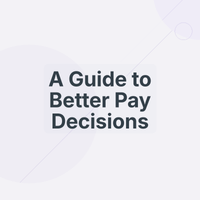
Workforce Planning + Compensation Structure = ROI
A well-designed compensation program is crucial for any company’s success. It requires a thoughtful and structured approach, as well as the use of reliable market data to establish compensation ranges. By proactively workforce planning, companies can allocate resources and budget more effectively.
Job leveling sets the foundation for compensation
Job leveling is the foundation for compensation ranges. As a bonus, it allows managers to create career paths and growth opportunities for employees and more accurately analyze employees’ pay against the market.
As Lola Han, CEO & Founder of Kamsa, emphasizes, "Early adoption of job leveling and a well-structured compensation framework pays off. It allows you to attract and retain your most valuable asset — your people — and make smarter use of your budget."
Once you’ve conducted job leveling, you’re ready to leverage market compensation data to establish (or update) your compensation structure. Next, fine-tune the compensation program with your leaders (before communicating it to employees).
Get leaders on board with the compensation strategy
It’s essential to be in alignment with your leaders (and even your board) on a clear compensation philosophy and strategy.
Incorporating business goals within your philosophy ensures that your approach thoughtfully spends the company’s budget. For example, use reliable market data to establish salary ranges by country/location.
Also, create priority tiers for how you use your budget by targeting the minimum to the midpoint of the range for employees who are newer and less experienced in their role vs. differentiate (provide higher percentage increases) for high performers.
Companies are also hiring globally and tapping into talent in countries that have lower cost of labor and living to lower recurring expenses on salaries. Leveraging reliable, global market data is imperative to avoid underutilizing or spending too much of the budget.
Combine compensation with workforce planning
A best friend to compensation structure is workforce planning. It ensures the company has the critical talent it needs to optimally thrive. Workforce planning enables meaningful conversations between leaders and employees to achieve organizational objectives more efficiently, thus, having the following quick impact on a company's ROI:
- Utilize workforce efficiently
- Smarter hiring and pay decisions
- Optimize revenue generation
Let’s dive into the steps you can take to proactively workforce plan to achieve the ROI above:
- Identify Skills Gaps - Conduct job leveling and establish career paths across the org (in collaboration with leaders) to get a better sense of business needs and what skills are critical. Then, compare critical skills to the current workforce’s skills and identify gaps.
- Resource Optimization - Identify areas where additional talent may be needed based on the skills gaps identified, as well as areas where workforce adjustments can lead to cost savings.
- Hiring Thoughtfully - Going through steps 1 and 2 above help organizations and their leaders ensure they’re only hiring for jobs that are essential for business growth.
- Training & Development - Implement learning and development programs to upskill existing employees and prioritize areas where skills gaps are present to ensure competencies meet future company goals and challenges.
- Succession Plan for Critical Roles - Identify the critical and single-source of failure roles. Then, to ensure smooth transitions and reduce impact of sudden departures for leadership and other critical roles, proactively groom top talent/high potential employees for these roles to reduce revenue impact of sudden attrition.
Compensation is a company's largest expense. The workforce planning initiatives above allow organizations to minimize costs by quickly identifying skills gaps, optimally assessing whether to hire externally or grow talent internally, and maximize revenue because the right roles are filled at the right time to capitalize on driving business growth. Companies that job level across their organization and workforce plan (at least annually) make better hiring and pay decisions, and ultimately achieve higher profitability.
About Kamsa
Kamsa is a compensation management solution that helps companies and leaders make thoughtful, data-driven pay decisions via their proprietary global market compensation data. Kamsa’s hybrid approach (technology + consulting) to compensation helps companies painlessly: define their compensation philosophy, conduct job leveling, establish compensation ranges, and assess their employees' pay against the market.


